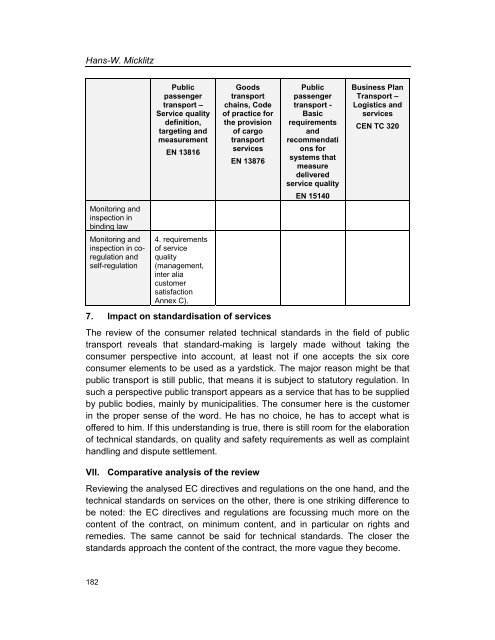Services Standards: Defining the Core Consumer Elements ... - ANEC
Services Standards: Defining the Core Consumer Elements ... - ANEC
Services Standards: Defining the Core Consumer Elements ... - ANEC
Create successful ePaper yourself
Turn your PDF publications into a flip-book with our unique Google optimized e-Paper software.
Hans-W. Micklitz<br />
Monitoring and<br />
inspection in<br />
binding law<br />
Monitoring and<br />
inspection in coregulation<br />
and<br />
self-regulation<br />
Public<br />
passenger<br />
transport –<br />
Service quality<br />
definition,<br />
targeting and<br />
measurement<br />
EN 13816<br />
4. requirements<br />
of service<br />
quality<br />
(management,<br />
inter alia<br />
customer<br />
satisfaction<br />
Annex C).<br />
Goods<br />
transport<br />
chains, Code<br />
of practice for<br />
<strong>the</strong> provision<br />
of cargo<br />
transport<br />
services<br />
EN 13876<br />
7. Impact on standardisation of services<br />
Public<br />
passenger<br />
transport -<br />
Basic<br />
requirements<br />
and<br />
recommendati<br />
ons for<br />
systems that<br />
measure<br />
delivered<br />
service quality<br />
EN 15140<br />
Business Plan<br />
Transport –<br />
Logistics and<br />
services<br />
CEN TC 320<br />
The review of <strong>the</strong> consumer related technical standards in <strong>the</strong> field of public<br />
transport reveals that standard-making is largely made without taking <strong>the</strong><br />
consumer perspective into account, at least not if one accepts <strong>the</strong> six core<br />
consumer elements to be used as a yardstick. The major reason might be that<br />
public transport is still public, that means it is subject to statutory regulation. In<br />
such a perspective public transport appears as a service that has to be supplied<br />
by public bodies, mainly by municipalities. The consumer here is <strong>the</strong> customer<br />
in <strong>the</strong> proper sense of <strong>the</strong> word. He has no choice, he has to accept what is<br />
offered to him. If this understanding is true, <strong>the</strong>re is still room for <strong>the</strong> elaboration<br />
of technical standards, on quality and safety requirements as well as complaint<br />
handling and dispute settlement.<br />
VII. Comparative analysis of <strong>the</strong> review<br />
Reviewing <strong>the</strong> analysed EC directives and regulations on <strong>the</strong> one hand, and <strong>the</strong><br />
technical standards on services on <strong>the</strong> o<strong>the</strong>r, <strong>the</strong>re is one striking difference to<br />
be noted: <strong>the</strong> EC directives and regulations are focussing much more on <strong>the</strong><br />
content of <strong>the</strong> contract, on minimum content, and in particular on rights and<br />
remedies. The same cannot be said for technical standards. The closer <strong>the</strong><br />
standards approach <strong>the</strong> content of <strong>the</strong> contract, <strong>the</strong> more vague <strong>the</strong>y become.<br />
182
















